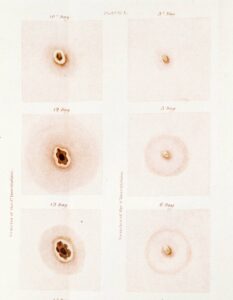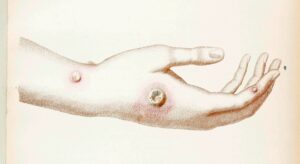Some say that the coronavirus vaccines are a ploy to inject the public with microchips that will constantly track your location; others claim that they’ll hook you up to the 5G network and make you explode. Some people think that the vaccine will rewrite your DNA in order to work, while others tweet about how the COVID-19 vaccines cause fertility issues.
Along with the viral pandemic, the world has reckoned with an onslaught of misinformation and fearmongering conspiracies regarding the COVID-19 vaccines. Yet such fears over vaccines aren’t new. Before the coronavirus pandemic there was the general misconception that vaccines cause autism (due to the unfortunate proliferation of a now-debunked study). Even when the cure was a better fate than the malady, the earliest vaccines were seen with suspicion and horror — demonstrated by the history of the smallpox vaccine.
Smallpox was a deadly disease, with epidemics occurring every four to seven years in the 18th century. The National Center for Biotechnology Information believes that 400,000 people were dying annually to the virus in Europe during that time. Those that didn’t die (and many did, with estimated case-fatality rates ranging from 20-60%) were often left with extreme scarring. Symptoms included vomiting, fatigue, fever, and even mouth ulcers and skin rashes that would then turn into pustules. Graphic descriptions of those afflicted include accounts of being covered in pustules and skin being covered with crusts of pus.
As a gruesome affliction, it is then no wonder that people sought ways to remedy or alleviate the disease. Early accounts acknowledge that places outside of Europe sought to protect their people from severe smallpox by artificially introducing viral matter into the system. China practiced a method known as insufflation as early as the 16th century, where smallpox pustules were dried and then made into a powder that was then inhaled.
Other groups in places such as India, parts of Africa, and the Ottoman Empire also practiced inoculation, which was an early form of vaccination. Unlike insufflation, inoculation (also known as variolation, named after the variola virus that causes smallpox) involved physically breaking the skin to expose the body to infectious smallpox material (usually from smallpox pustules); this was usually accomplished by scratching the skin with a needle. Doing so would induce a milder case of the disease with a greater rate of survival while also hopefully protecting the- target from a more fatal infection in the future.

The knowledge of inoculation was introduced to England from the Ottoman Empire (now Turkey) by Lady Mary Montagu, British noblewoman whose husband served as the ambassador to the Empire. While living in Constantinople she noted the lack of pox-scarring amongst the locals. Having learnt about inoculation she thus arranged to have her son inoculated against the disease. She and her family returned to England in time for a smallpox epidemic in 1721 where she introduced the practiwce by having her physician, Charles Maitland, inoculate her daughter. Lady Montagu’s social standing and connections meant that eventually some of the King’s grandchildren were inoculated, thereby increasing the popularity of the practice among the British upper echelons and other parts of society.
Even so, inoculation wasn’t perfect. Although smallpox introduced by inoculation had a lower death rate, it was still possible to die from inoculation-induced smallpox. Furthermore, there were concerns about spreading the disease once smallpox was induced in its target as well as concerns about spreading other disease on accident, such as syphilis. Although a much safer choice when weighed against the fate of those who contracted the disease naturally, inoculation was not without its own risks.
The first modern vaccine as we know it is credited to Edward Jenner, a physician from Gloucester who was also a student of John Hunter. Although Jenner is “credited” with the first vaccine (the word itself coming from variolae vaccinae, denoting its connection with cowpox), perhaps it is more accurate to say he pioneered the concept of vaccines and smallpox vaccinations as credit and history is often more about achieving widespread recognition of the concept rather than being the true first. Growing up, it was commonly accepted that dairymaids were somehow safe from smallpox; this was usually linked to the fact that they had previously been afflicted with cowpox. Jenner himself was not unfamiliar with the idea of inducing infection in order to stave off more deadly afflictions of diseases, as he himself had been inoculated with smallpox as a child. Having studied medicine and surgery, Jenner decided to conduct experiments regarding the use of cowpox to induce immunity to smallpox. In 1796, Jenner inoculated eight-year-old James Phipps with cowpox pustule materials taken from the hands of dairymaid Sarah Nelmes. Although Phipps was later exposed to smallpox material, he did not get sick with the disease, thereby proving the efficacy of Jenner’s vaccine.

Jenner attempted to publish his findings in 1797 but was rejected. With later revisions he was finally able to publish a small booklet in 1798 titled, “An Inquiry into the causes and effects of the variolae vaccinae, a disease discovered in some of the wester counties of England, particularly Gloucestershire and known by the name of cow pox.” Vaccination slowly achieved popularity in London, in part due to Henry Cline, a surgeon whom Jenner had shared some of the vaccine material with. By 1800 the use of vaccination had spread to most European countries.

Yet despite the overall success of vaccination, there were both medical and non-medical practitioners that opposed the practice. Physicians such as Dr. Benjamin Moseley and William Rowley were outspoken opponents of vaccines who published materials claiming that the vaccines would cause physical deformities such as the growth of horns, or even provoke a desire to mate with bovines and thereby would bring about human-cow hybrids.
“Moseley had said that ‘owing to vaccination the British ladies might wander in the fields to receive the embraces of the bull … Who knows but from vaccination a brutal fever will arise, and hence some modern Pasiphae may rival the fables of old’ !!!!”
In response, English author and doctor Robert John Thornton (1768-1837) published an attack on Moseley and Rowley’s claims, thereby presenting a defense for Jenner’s theories and work.
Becker Medical Library acquired this first edition copy of Vaccinae vindicia (defense of vaccination) in 2021. It includes images taken from Moseley and Rowley’s works, which were sincere in the original works, but reprinted by Thornton with the intent to ridicule anti-vaccination fears. The work also collects letters and other correspondence from those who were in support of vaccines as well as evidence refuting those that attacked the practice. Thornton’s comments in his dedication will resonate eerily with modern audiences:
“Yet the instant the promulgation of vaccination was made, the sordid idea of self-interest ceased, and nearly with one voice, every heart panted to see this horrible disease banished from the earth, and it was thought it would soon be known in Britain only by its name. But, alas! Instead of inquiry being steadily pursued, and fair inductions made, an unexpected opposition arose ; and the whole science of vaccination was thrown into chaos, and the reverse of the truth was made the title pages of books, and the public were deluded by men, who, to speak the least in their disfavor, should have known better.”
Throughout the work Thornton attacks the anti-vaccination movement, declaring that people such as Moseley and Rowley were “a disgrace to the age, the country, and the profession” for their outlandish claims about the effects of vaccination. “…Notwithstanding the most incontestable proofs of such misrepresentations,” he writes in the footnotes, “a FEW MEDICAL MEN have persisted in repeatedly bringing the same unfounded and refuted reports, and misrepresentations, before the public, thus perversely and disingenuously labouring to excite prejudices against Vaccination.” Thornton hauntingly signs off his dedication with a quote from the Iliad — “On their account the people die.”
You can peruse Vaccinae vindicia and other rare medical texts in Becker’s Archives and Rare Books, located on the seventh floor. The collections are open to the public from Monday through Friday, 9 AM-5 PM. Make an appointment via arb@wusm.wustl.edu or call us at (314) 362-4236.
Sources and references:
Centers for Disease Control and Prevention. (2021, February 20). History of smallpox. Centers for Disease Control and Prevention. Retrieved December 7, 2022, from https://www.cdc.gov/smallpox/history/history.html
Penschow, J. D. (2022). Battling smallpox before vaccination inoculation in eighteenth-century Germany. Brill.
Riedel, S. (2005, January). Edward Jenner and the history of smallpox and vaccination. U.S. National Library of Medicine. Retrieved December 7, 2022, from https://www.ncbi.nlm.nih.gov/pmc/articles/PMC1200696/
Thornton, R. J. (1806). Vaccinae vindicia; or, Defence of vaccination: containing a refutation of the cases, and reasonings on the same, in Dr. Rowley’s and Dr. Moseley’s late extraordinary pamphlets against vaccination. In two letters to Dr. Moseley, with the report of the Medical Council of the Royal Jennerian Society and the debate in the House of Commons (July 2, 1806) on a motion by Lord Henry Petty, for enlightening the people of England on the subject of vaccination … H.D. Symonds.
